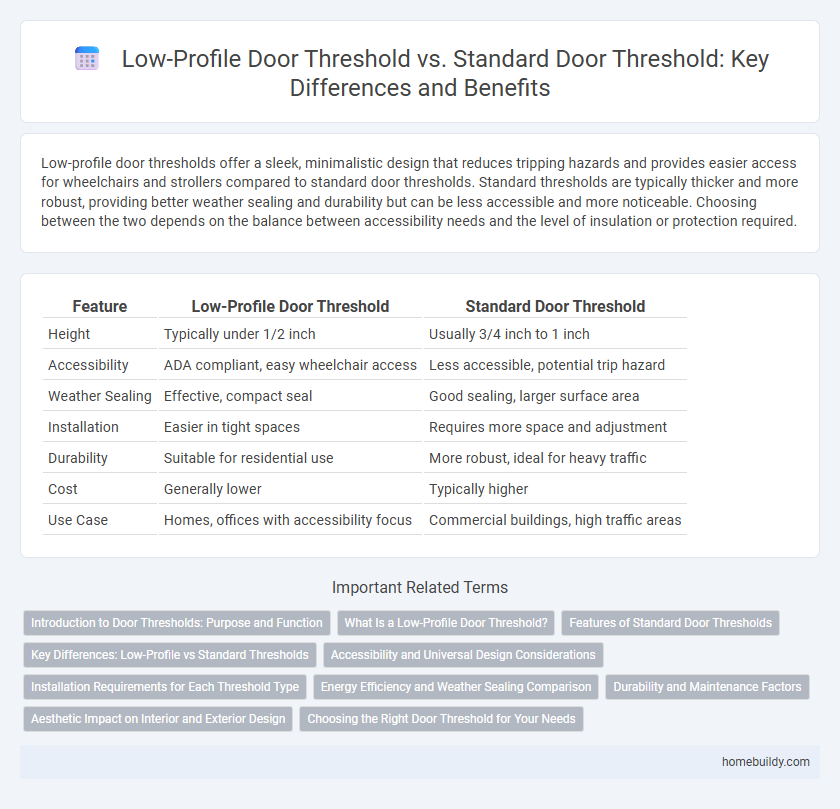Low-profile door thresholds offer a sleek, minimalistic design that reduces tripping hazards and provides easier access for wheelchairs and strollers compared to standard door thresholds. Standard thresholds are typically thicker and more robust, providing better weather sealing and durability but can be less accessible and more noticeable. Choosing between the two depends on the balance between accessibility needs and the level of insulation or protection required.
Table of Comparison
| Feature | Low-Profile Door Threshold | Standard Door Threshold |
|---|---|---|
| Height | Typically under 1/2 inch | Usually 3/4 inch to 1 inch |
| Accessibility | ADA compliant, easy wheelchair access | Less accessible, potential trip hazard |
| Weather Sealing | Effective, compact seal | Good sealing, larger surface area |
| Installation | Easier in tight spaces | Requires more space and adjustment |
| Durability | Suitable for residential use | More robust, ideal for heavy traffic |
| Cost | Generally lower | Typically higher |
| Use Case | Homes, offices with accessibility focus | Commercial buildings, high traffic areas |
Introduction to Door Thresholds: Purpose and Function
Low-profile door thresholds offer a minimal height transition, enhancing accessibility and reducing trip hazards compared to standard door thresholds, which typically have a higher profile and provide a more pronounced separation between spaces. Both types serve essential functions such as sealing gaps under doors to prevent drafts, water intrusion, and pest entry, while contributing to energy efficiency and interior comfort. Choosing the appropriate threshold depends on factors like door type, traffic flow, and building codes related to accessibility and safety.
What Is a Low-Profile Door Threshold?
A low-profile door threshold is a slim and minimalistic transition strip designed to reduce tripping hazards by creating a smoother, lower elevation change between rooms or floors. Unlike standard door thresholds, which typically have a more prominent height and bulk, low-profile thresholds enhance accessibility and comply with ADA standards for barrier-free environments. These thresholds are ideal for residential and commercial spaces requiring seamless passage while maintaining weather sealing and durability.
Features of Standard Door Thresholds
Standard door thresholds typically feature a raised profile designed to seal gaps between the door and floor, enhancing energy efficiency and preventing drafts. Constructed from durable materials such as aluminum, wood, or vinyl, they provide robust weather resistance and can accommodate various door sizes and types. These thresholds often include a sloped surface to facilitate water runoff, reducing the risk of moisture intrusion and increasing overall longevity.
Key Differences: Low-Profile vs Standard Thresholds
Low-profile door thresholds typically measure under 1/2 inch in height, offering a minimal step-over for improved accessibility and smoother transitions between rooms. Standard door thresholds are generally taller, around 3/4 inch to 1 inch, providing better durability and sealing against drafts, moisture, and pests. The key differences lie in height, accessibility, and weatherproofing efficiency, with low-profile thresholds favored for ADA compliance and standard thresholds preferred for enhanced insulation and protection.
Accessibility and Universal Design Considerations
Low-profile door thresholds enhance accessibility by minimizing tripping hazards and allowing smoother transitions for wheelchair users and those with mobility impairments. Standard door thresholds, often higher and bulkier, can obstruct easy passage and fail to meet Universal Design standards that promote barrier-free environments. Implementing low-profile thresholds supports inclusive design, ensuring compliance with ADA guidelines and improving overall safety and comfort for all users.
Installation Requirements for Each Threshold Type
Low-profile door thresholds require minimal floor modification, making installation easier in spaces with limited clearance or uneven flooring. Standard door thresholds demand precise floor leveling and sometimes additional subfloor work to ensure a secure fit and proper sealing. Proper measurement and surface preparation are critical for both types, but standard thresholds typically involve a more complex installation process due to their height and design.
Energy Efficiency and Weather Sealing Comparison
Low-profile door thresholds offer superior energy efficiency by minimizing air gaps, which reduces heat loss and improves indoor temperature control compared to standard door thresholds. Their streamlined design enhances weather sealing capabilities, effectively blocking drafts, moisture, and dust infiltration to maintain consistent insulation. This optimized barrier contributes to lower energy bills and increased comfort in homes and commercial spaces.
Durability and Maintenance Factors
Low-profile door thresholds typically feature enhanced durability due to their streamlined design, which reduces wear from foot traffic and environmental exposure. Standard door thresholds often require more frequent maintenance because their raised edges can collect dirt and moisture, leading to faster degradation. Choosing low-profile options can minimize upkeep needs and extend the lifespan of the threshold, especially in high-traffic or harsh weather conditions.
Aesthetic Impact on Interior and Exterior Design
Low-profile door thresholds create a seamless, minimalist transition between rooms, enhancing modern interior aesthetics by reducing visual and physical barriers. Standard door thresholds, while more noticeable, can complement traditional and rustic designs by adding a defined architectural element. Choosing between low-profile and standard thresholds influences not only the flow of space but also the overall harmony between interior and exterior design styles.
Choosing the Right Door Threshold for Your Needs
Low-profile door thresholds offer a sleek design with minimal height, ideal for accessibility and seamless transitions in modern homes or commercial spaces. Standard door thresholds, typically taller and more robust, provide enhanced durability and better weatherproofing for exterior doors exposed to harsh elements. Selecting the right door threshold depends on balancing aesthetic preferences, accessibility requirements, and environmental conditions to ensure optimal functionality and comfort.
low-profile door threshold vs standard door threshold Infographic

 homebuildy.com
homebuildy.com